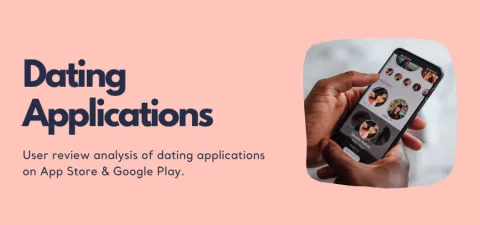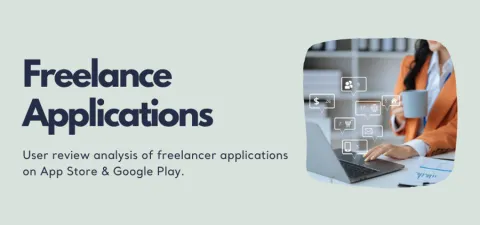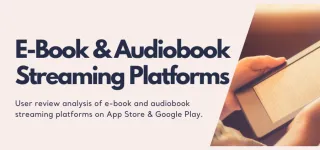Understanding Calorie Tracking and Nutrition Apps Through Customer
Dec 08, 2025 - 16 minute read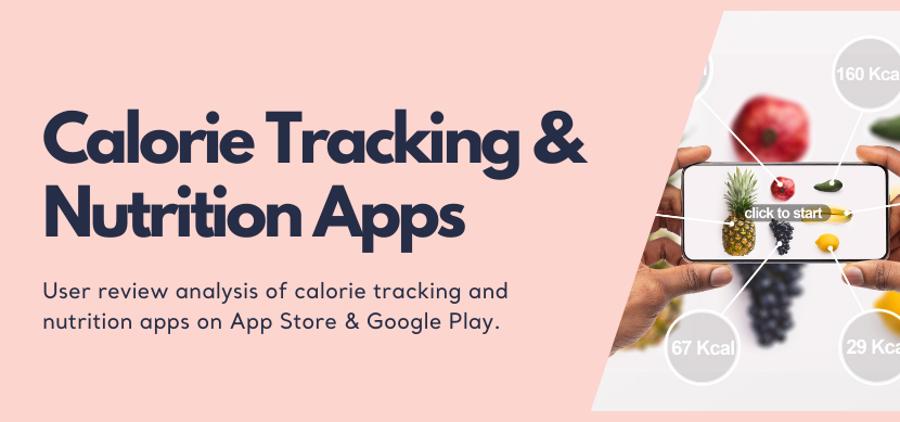
One day, while sitting comfortably on the couch and browsing through old photos, a picture from a vacation a few years ago suddenly caught your eye. Back then, you remembered how healthy and fit you were. Now, however, the reflection you see in the mirror feels like a distant memory of your former self. At that moment, you realized that something needed to change. You decided to take action, but you were confused about what to do and how to do it. You struggle with every diet you start, fail to maintain fitness routines, and eventually return to your old habits. Over time, this cycle can become exhausting.
Apps like MyFitnessPal, Lose It!, and Yazio stand out in this complex world. Why did we examine only these three apps? Because each one has its own strengths and weaknesses, as highlighted by user feedback. The comments made by their users serve as clues, showing us where these tools excel and where they fall short. This is where Kimola’s analysis comes into play, harnessing the power of user feedback.
Methodology
To understand what drives the success of calorie tracking and nutrition apps, we focused on user feedback as the most authentic source of insight. Reviews reveal what users enjoy, where they struggle, and what keeps them coming back. By conducting Customer Experience (CX) Research and Qualitative Research, we analyzed the direct experiences shared by users.
We collected 1,500 reviews—250 from each app (MyFitnessPal, Lose It!, and Yazio)—from Google Play and the App Store. Using Sentiment Analysis and Text Analysis, we applied Natural Language Processing (NLP) to uncover recurring themes and identify common pain points. Named Entity Recognition (NER) helped us identify key features mentioned in the feedback.
Through this process, we also created Buyer Personasby clustering users with similar behaviors and needs. This allowed us to gain a deeper understanding of the customer journey and identify areas for improvement in the apps.
For those interested in exploring similar analyses, you can sign up for a free Kimola account and start uncovering valuable insights from customer feedback today.
User Motivations: Why We Use Calorie Tracking and Nutrition Apps
Users are drawn to weight management apps for a variety of reasons, but their motivations often center around key areas that directly support their health and fitness goals. Based on customer feedback and feature usage, the motivations can be categorized into the following themes:
Calorie Tracking
The primary motivation for many users is to keep track of their daily calorie intake. By monitoring their food intake, users gain greater awareness of their eating habits and can take control of their nutrition. The app provides an organized way to log meals, set calorie limits, and track progress, making it an indispensable tool for those looking to lose weight or maintain a healthy diet.
Comprehensive Food Database
Another major motivator is the food database that many of these apps offer. Users appreciate having access to a wide variety of foods and nutritional information. However, some feedback suggests that this feature is often limited, with users seeking more accurate data and a broader selection of food items. This allows them to enter and track even more specific foods, contributing to better data accuracy in their nutrition journey.
Weight Management
For users focused on weight loss or maintaining their current weight, apps that offer weight tracking features are highly valued. These apps provide users with tools to track their progress, set weight goals, and visualize changesover time. The ability to monitor progress daily or weekly motivates users to stay consistent in their efforts.
Exercise Integration
Fitness enthusiasts find that apps that integrate exercise tracking with nutrition management are particularly useful. Many users seek to track both calories consumed and calories burned through exercise, making integration with fitness devices or apps crucial. By syncing data, users can get a holistic view of their health progress, ensuring both dietary and exercise efforts align.
Customizable Food Entries
Users appreciate the flexibility to manually enter foods and drinks that are not found in the app's database. This customization is essential for people with unique dietary needs or who consume homemade meals. The ability to edit and personalize the app’s food database ensures that users can log their intake accurately, even when the app's pre-existing database lacks specific items.
Meal Planning
Some users are drawn to apps that offer meal planning tools. These features help them organize meals, create shopping lists, and stay on track with their dietary goals. Planning ahead saves time and helps prevent unhealthy food choices, making it a key motivator for those looking to stick to a long-term healthy eating plan.
Intermittent Fasting Tracking
Apps that offer intermittent fasting tracking are a growing motivator for users who follow fasting routines. Many users value the ability to track fasting hours and set reminders, which helps them adhere to their fasting schedules and manage eating windows effectively.
Nutrition Analysis
Users are increasingly looking for apps that offer detailed nutrition analysis, allowing them to track both macro and micronutrients. While users find these features useful, there is often frustration with inaccuracies or gaps in the nutritional data. Accurate tracking of these nutrients is important for users who want to maintain a balanced diet.
User Experience Improvements
Many users express frustration with the user interface (UI), especially when excessive ads, pop-ups, and sudden UI changes disrupt their experience. A smooth, intuitive UI is critical for maintaining user engagement. Negative feedback often centers around these interruptions, leading users to seek apps with less intrusive design elements.
Community Motivation
Some users are motivated by the social and community aspects of weight management apps. Features like challenges, social sharing, and community forums encourage users to stay committed to their health goals by engaging with like-minded individuals. These social tools help users find support and accountability on their fitness journeys.
Thematic and Sentiment Analysis of Calorie Tracking and Nutrition Apps
User feedback on weight management apps reveals the key elements that shape experiences.Thematic Analysis and Sentiment Analysis highlight the main topics of user experience, calorie tracking, subscription models, and ad overload.
1. User Experience and Interface
Kimola’s analysis shows that 46% of users experience issues with Yazio’s user interface. Frequent crashes and bugs make it difficult for users to log their meals, and excessive ads negatively impact functionality. Among MyFitnessPal users, 31% left reviews, with 67% expressing dissatisfaction due to its complex interface. On the other hand, 61% of Lose It! users find the user experience positive and describe the interface as useful and easy to understand. Additionally, 16% of Lose It! users highly appreciate the app’s motivational features. These features, such as setting daily goals and engaging with the community, play a significant role in maintaining motivation during the weight loss journey. Users can interact with others through forums, groups, or social sharing spaces, and 95% of them find this support beneficial for staying motivated and connecting with like-minded individuals.
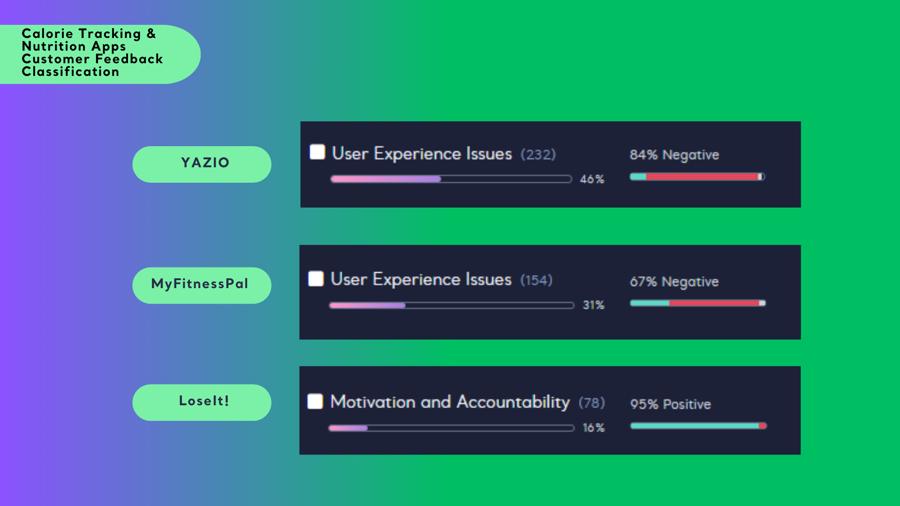
2. Calorie Tracking and Food Database
One of the most critical factors in calorie tracking apps is the accuracy of food data. While 72% of MyFitnessPal users report inaccuracies in the food database, 65% still consider the app effective for calorie tracking. Similarly, 97% of the 18% of Yazio users who provided feedback are dissatisfied with the accuracy of the food database, citing errors in calorie counts, portion sizes, and nutritional details. Meanwhile, 78% of Lose It! users are generally satisfied with the calorie tracking system, and 90% report significant weight loss success, attributing it to the app’s robust food tracking features. Many users note that consistent calorie tracking enhances awareness and helps improve eating habits.
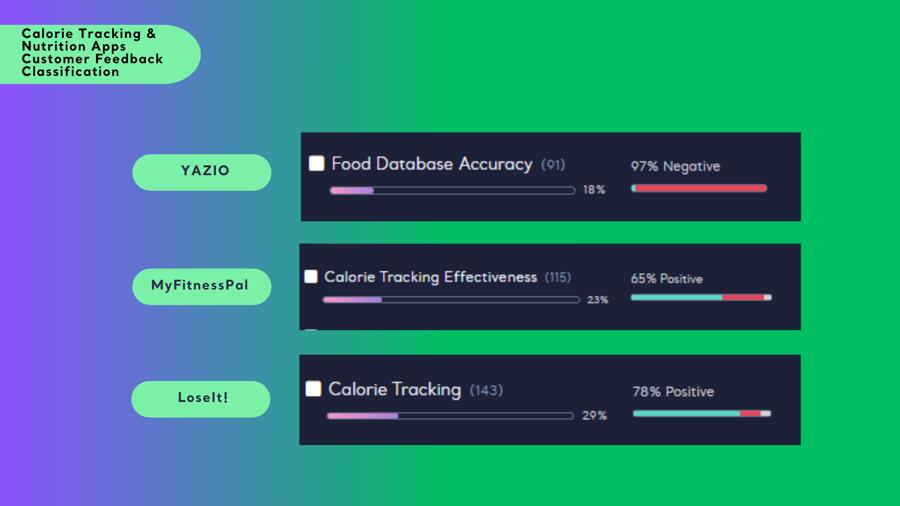
3. Pricing and Subscription Models
According to Kimola’s data, 97% of MyFitnessPal users are unhappy with the app’s premium membership pricing, describing it as overly expensive. Likewise, 95% of Yazio users find the subscription system unbalanced, with frequent complaints about misleading advertisements regarding free trials and intrusive ads appearing after meal logging. However, 40% of Lose It! users appreciate the additional features provided in the premium version. Users who opt for premium membership find the advanced nutritional analysis and goal-settingfeatures useful. Some users, however, express frustration about encountering ads despite having paid for the service.
4. Ads and Pop-up Issues
The overload of ads and pressure to upgrade to premium membership negatively affect user experience. Pop-ups, which are small windows that appear unexpectedly while performing an action, are a common complaint. Among 25% of Yazio users who provided feedback, 96% say the app contains excessive ads that interfere with effective calorie tracking. Similarly, 95% of 9% of MyFitnessPal users report frustration with persistent ads and premium upgrade prompts. The constant full-screen ads and upgrade notifications significantly impact user satisfaction. Meanwhile, 97% of 13% of Lose It! users complain about frequent ads, especially full-screen and unskippable ones, which make the app almost unusable for some. As a result, many users consider premium membership a reasonable option to eliminate ads.
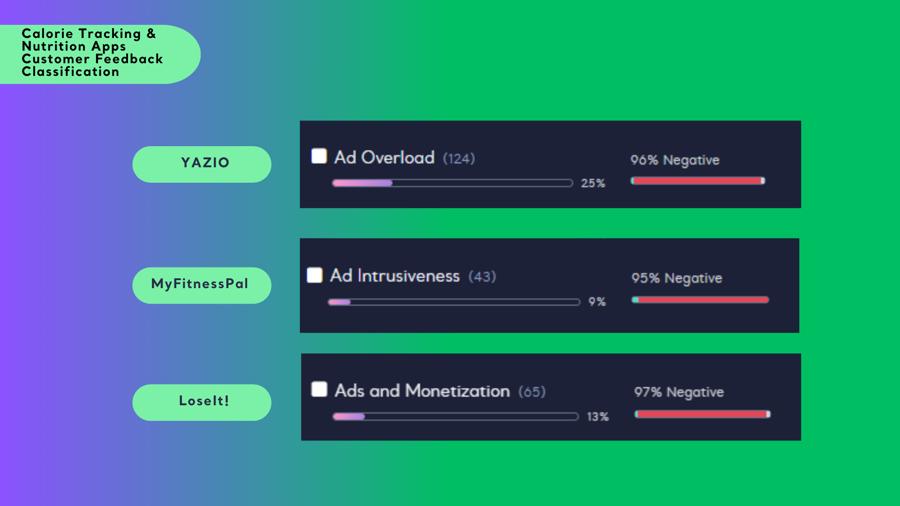
Who Uses Calorie Tracking and Nutrition Apps?
Users of weight management apps come from various backgrounds with different motivations and expectations. According to the Buyer Persona analysis conducted by Kimola, here are the most common user profiles:
1. Frustrated Newbie (29%) – The Newbie Who Gets Frustrated Quickly
This persona is the type who says, "One more kilo? Fine, I’ll start!" but a few weeks later is asking, "Why are there so many food lists?" They’re eager to begin but often find themselves lost in the sea of apps. This user has a serious aversion to apps that ask for too much personal information and have complex interfaces. They scream, "Just keep it simple!" because without educational resources and community support, things aren’t going to work. Also, they absolutely don’t want to deal with more ads! If the ads were a little less intrusive, they might give it a chance.
2. Disheartened Veteran (18%) – The Old App Star Who Lost Its Shine Due to Ads
This persona is filled with nostalgic feelings from the past. They’ve been using diet apps for years and know very well when ads became a thing. This user now says, "Let’s go back to the simpler times!" They are a veteran of life itself, so tired of ads that they find themselves searching through the dark corners of the internet for old apps. This persona expects loyalty from apps. They firmly state, "I can’t stand either ads or excessive payment demands!"
3. Skeptical Subscriber (17%) – Cautious About Subscriptions, But Not Totally Against Them
This persona is always cautious about subscriptions, having once enjoyed the perks of free apps, believing, "Everything can be free." Now, they’re skeptical about premium features. "Why are there so many ads?!" they keep asking, and all they want is a simpler experience. If something truly valuable is promised, they might accept the premium membership, but only if the promises are kept.
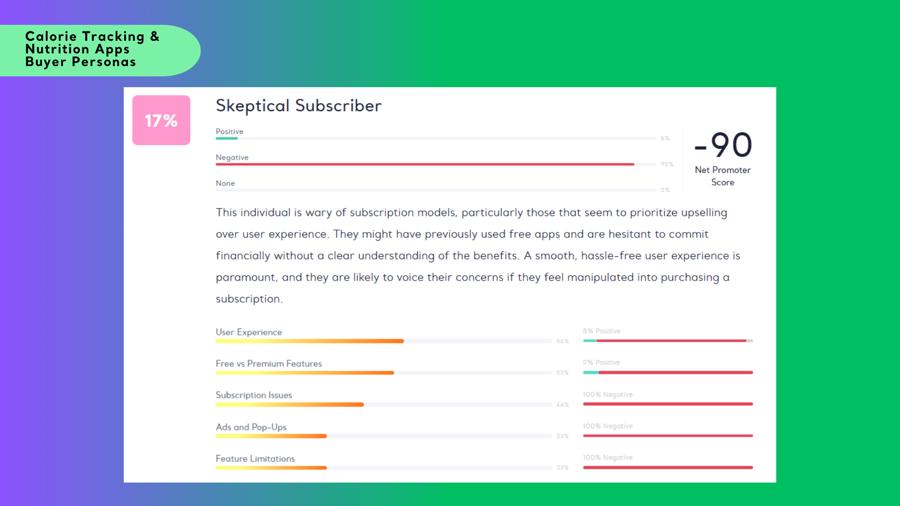
4. Dedicated Dieter (9%) – "I Have Goals, But I Can't Get Through These Ads!"
This user is on a serious diet with a clear goal, but they’re frustrated because they think, "I can’t stay motivated with all these ads!" As a "motivation monster," they do question the accuracy of some features and data. However, they’re determined to reach their goals. They say, "Still, I dream of an ad-free world." If the app works properly, success is inevitable.
5. Health-Conscious Tracker (8%) – Health-Oriented, But Doesn’t Want to Run Away From Ads
This user is serious about healthy living, but a bit too meticulous. They believe every calorie and measurement has to be perfect. Their main goal is: "Less ads, more information!" If the app provides the right data, they will be a loyal user once again. They stay motivated by saying, "A good diet suggestion and a correct food database are all I need!"
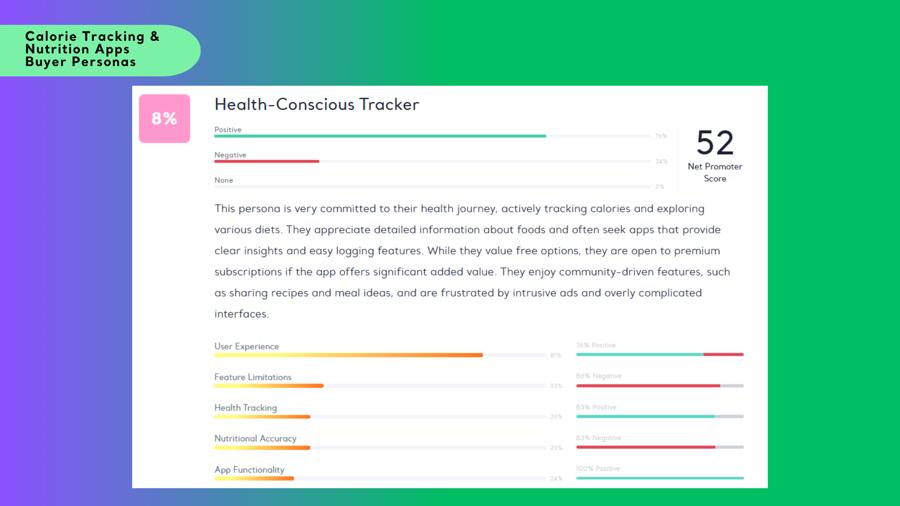
6. Tech-Savvy Health Guru (7%) – I Love Technology, But If The App is Slow, I’m Out
This persona isn’t just into healthy living—they also love technology. They use all kinds of fitness trackers, smartwatches, and devices, and they immediately check if the app is compatible with these gadgets. "If my device tracks me, the app should track me too!" they say. But if the app is technologically weak or crashes from time to time, they quickly move on to another app. Still, they’re willing to pay for premium features and innovation.
7. Casual User (4%) – My Lifestyle is Simple, But Always Accessible
This person isn’t deeply involved in counting calories, but they occasionally feel the need to be a little more mindful. "Yes, I care about healthy living, but I’m not obsessed," is their mantra. What matters most to them is simplicity—quick meal logging, a few tips, and a "No ads, simple experience." They don’t have big goals, but if they decide to make a change, they value a user-friendly app.
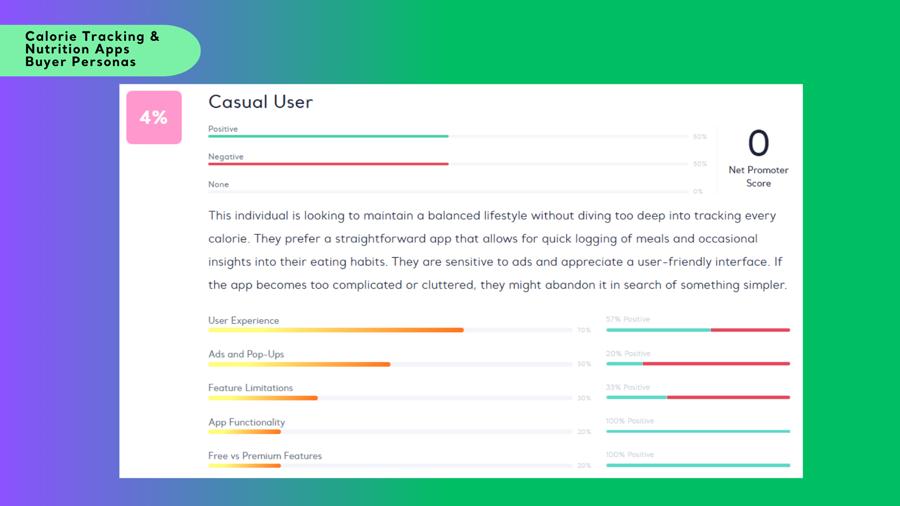
8. Social Dieter – Share, Like, Follow, But Please, No Ads!
This persona enjoys sharing their diet with a community. They dream of a world where food recipes, health tips, and success stories are all part of a social environment. "Follow me, and I’ll follow you!" they say. For them, the most important aspect of the app is social connection. However, encountering an ad would make this user quickly leave. "Healthy living, but no ads."
What Should an Ideal Calorie Tracking and Nutrition App Look Like?
Imagine an app that truly meets every user’s needs—an app that makes your daily tasks effortless and enhances your experience without unnecessary complications. Based on in-depth analysis of user feedback, here's what an ideal app would look like:
A Seamless Food Logging Experience
At its core, the app would allow users to log meals with ease. With an extensive food database covering a wide range of global cuisines and brands, users could quickly search and log meals in seconds. The app would also offer a custom food logging feature, allowing users to manually add rare or homemade dishes, ensuring every meal is accounted for.
Precision Tracking, Tailored to Your Needs
Rather than offering just generic calorie counting, the app would provide detailed macronutrient tracking—helping users monitor proteins, fats, carbs, and essential vitamins and minerals. The app would customize recommendations based on individual goals, such as weight loss, muscle gain, or maintaining a balanced diet, ensuring users stay on track to meet their nutritional needs.
Food Database That Grows with You
The app would feature an ever-expanding food database, constantly updated based on user input and global trends. Unlike other apps where users often encounter missing or inaccurate food items, this app would rely on community contributions to ensure that even niche or regional foods are added promptly. The database would be reliable, accurate, and up-to-date, providing detailed nutritional breakdowns for a variety of foods, from packaged goods to fresh produce.
Instant Barcode Scanning for Quick Entry
Say goodbye to tedious manual input. With a barcode scanner, users can quickly scan food labels to instantly retrieve nutritional information, making meal logging quick and easy. This feature would apply to both packaged foods and dining out experiences, ensuring maximum convenience. For those who don’t have barcode access, manual entry would ensure no meal is missed.
Sync with Fitness Devices for Holistic Tracking
The app would seamlessly integrate with popular fitness devices like Fitbit, Garmin, and Apple Watch, allowing users to sync their exercise data with their food intake. This integration would provide a complete picture of health, showing how workouts influence nutrition and vice versa, helping users make better decisions to reach their fitness goals.
Personalized Challenges and Social Motivation
To keep users motivated, the app would feature interactive challenges—such as daily or weekly meal logging goals, nutritional achievements, or fitness targets. A built-in social network would let users connect with friends and like-minded individuals, sharing tips, progress, and achievements. Challenges, leaderboards, and rewards would foster a sense of community and support, making the health journey feel more engaging and rewarding.
Motivating, Non-Disruptive Ads Experience
While most features would be available for free, the app would offer a premium, ad-free experience. For users of the free version, the ads would be non-intrusive, appearing only as small banners to maintain a smooth, uninterrupted experience. Premium users would also enjoy additional features like advanced meal planning and detailed nutrient analysis.
Consistent Updates and Community-Driven Improvements
The app would continuously evolve with regular updates, reflecting user feedback and the latest nutritional science. Users would have the opportunity to suggest new foods, provide feedback, and participate in the development process. This community-driven approach would ensure that the app remains reliable, efficient, and constantly improving—delivering a better experience for everyone.
This app would simplify the food tracking experience while providing robust features for users to reach their health and fitness goals. It's not just about tracking calories; it’s about building a comprehensive, personalized health ecosystem that empowers users to make informed decisions and stay motivated on their journey.
Conclusion & What's Next?
In conclusion, the analysis of user feedback on popular calorie tracking and nutrition apps reveals several critical areas where improvements are needed. Key concerns include the accuracy of food data, the need for a more intuitive user interface, and the reduction of intrusive ads. Users are increasingly seeking apps that offer a more personalized experience, providing tailored recommendations based on their individual nutritional needs. While these apps have certainly made strides in assisting users with calorie tracking and managing their diet, the demand for more reliable and comprehensive food databases remains high, as does the need for an overall smoother experience that prioritizes user convenience.
Looking forward, the next step in improving these apps lies in integrating user-driven insights into the ongoing development process. By focusing on user feedback, developers can enhance features such as food data accuracy, calorie tracking, and the user interface. Moreover, refining subscription models to be more transparent and balanced, while offering optional premium features, will help foster greater user engagement and satisfaction.
Kimola automatically collects customer feedback from major platforms such as the App Store, Google Play, X, Trustpilot, Tripadvisor, Amazon, and Google Business—transforming it into qualitative research reports with thematic analysis, sentiment breakdowns, buyer personas, usage motivations, and key insights.
If you're ready to take your business to the next level—making it more intuitive, accessible, and aligned with your users' expectations—create a free account on Kimola and start analyzing customer feedback instantly. Want a deeper dive? Request a demo with one of our professionals to explore how Kimola's powerful analytics can help you turn user insights into smarter business decisions.
